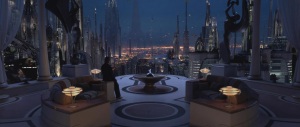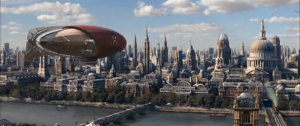In Architecture: Choice or Fate, his manifesto for New Urbanism, classicist Leon Krier produced many inspirational images of urban complexity, going as far as a fractal comparison of modern and traditional buildings. The cover of the book, a fictional resort town for Tenerife, presents a fascinating case study of complex symmetry; no building is the same as another, but all share the same geometric properties. That would not be unusual had it not been an architectural manifesto. Competent artists have always been able to imagine dream cities, and they continue to do so with every blockbuster fantasy movie that hits the screens.
The dream city of Coruscant in Star Wars
The dream city of Not London in The Golden Compass
Like the dream cities of Le Corbusier and his modernist colleagues, the dream cities of artists have in common the fact that none of them have ever been realized. Leon Krier's dream city, Poundbury, has been realized by the capital backing of a supernaturally rich patron, and even then it has been built very slowly and carefully. In the time it has taken to develop Poundbury, millions of urbanisations have occurred elsewhere. Like the New Urbanist TNDs of America, no matter how much we enjoy their architectural quality, we cannot consider them to be real cities. The real city has been built in the emergent dimension, not by the mind of a single artist but by the material necessities of all people. While it is fairly straightforward for an artist like Leon Krier to invent and apply his own form language to imagine a complex cityscape, in order for this design to be adapted to the material necessities of millions it must also involve millions. We obviously cannot burden a single artist with this task.
And so urbanism has a wholly different starting point from architecture. The artist does not have control. No one can possibly ever have control. Everything is happening all at once everywhere at once. To attempt to stabilize this process has caused chaos everywhere.
The starting point of urbanism is the same starting point that the founder of Wikipedia, Jimmy Wales, set for himself when he established the Internet's now most indispensable website. Instead of asking how to publish the expert opinion of specialists as an encyclopedia that would compete with the print powerhouses (a venture he had already attempted and failed at), Wales based his system on the theories of economist and complexity scientist Friedrich von Hayek. The idea that Hayek proposes is that there exists specific knowledge that only individuals possess, and that can only be utilized with their cooperation. Wales saw his task as the aggregation of this knowledge into one coherent system.
The world-wide-web had, since the early 90's, become a massively hyperlinked knowledge network that everyone could publish in. The reality at the time of Wikipedia's creation was that this power had not produced any kind of coherent system for basic knowledge. Aggregating knowledge had up to then been too complicated. Wales wanted, in his own words, to "make the Internet not suck." Overcoming this deficiency meant simplifying the production of web pages and hyperlinks, removing some unnecessary choices in the process. This is what the interface of Wikipedia did. Within a year, Wikipedia had grown explosively and exponentially. Making information easier to create and access had made it possible for the sum total of encyclopedic knowledge to be rapidly constituted.
This has come at a cost, however. While there is in theory unlimited freedom to add content that one considers relevant to Wikipedia, the form that this content will take on screen is very rigidly defined. This is necessary in order to achieve the complexity of the system. The design of Wikipedia is constant across every page in order to make it possible to rapidly navigate through all the information without having to relearn the rules for every article. Nevertheless, when we click on a link to a Wikipedia page, we never know what we are going to get. The design acts not as a constraint on the content, but as an enabler of the content. Without the rules enforced by Wikipedia, none of the content would have been added.
Wales and his foundation have been extremely controversial. On the one hand, in order for Wikipedia to work as it does, the foundation must provide all the support structures necessary to enable the users to create knowledge, and on the other hand it must also blindly trust the users to create information that will be accurate. It simply is not possible to control the content of so many millions of articles. To attempt this would necessarily shrink the size and reduce the complexity of the system, destroying what makes Wikipedia useful in the first place. The emergent dimension must either be embraced or rejected.
The lessons learned from Wikipedia can also be learned from the very rich past of urban planning. Historically the most successful cities have not been those who have had the least planning but the most enabling plans. The Manhattan plan of 1811, for example, provided for the flexible extension of a street grid without interfering in what could be built within the blocks, and so enabled a surge in urbanisation that was unmatched in history. Eventually this model reached its complexity limits and a new design for Manhattan was applied (with varying success), such as the building codes that gave us wedding-cake skyscrapers, and the metropolitan transit system of subways and later on expressways.
The darker side of this phenomenon has been the creation of city designs that inadvertently enabled the creation of a type of city that no one wanted. Every city, no matter how loudly the local authorities claim to be planning-free, have a design. Take the classical example of a "no planning" city, Houston. Although it has no zoning codes, Houston has a system for laying down a grid of roads that implies necessarily a large-scale, long-ride, automobile-dependent city. By their very form, these roads make some types of urbanisation easier and others more difficult. Who is going to build for a walkable neighborhood when there are no sidewalks? How can a TND make a walkable city when at every mile a thoroughfare cuts off the pedestrian links? How can a sustainable city emerge when only one form of link, long-range auto trips, can be made between destinations?
The threat that we face today is not suburban sprawl. New Urbanism and Smart Growth have been victorious in that aspect. The danger we face is dense sprawl, (see Eric Eidlin, The Worst of All Worlds Los Angeles and the Emerging Reality of Dense Sprawl) where our disconnected cities become denser and denser without becoming more complex, resulting in even poorer urban conditions. The suburb is not the design. Sprawl is the design.
Our cities may not be what we wanted, but they have not been accidents. They are the result of designs applied by the local (and sometimes not-so-local) authorities. They will only change if we invent and apply new designs for them. They cannot be architectural designs founded upon control of the artist. They also cannot be the endless grid of highway strips. Yet they must have both art and highways. It is a whole new method of design, emergent design, that we must master.
Reference


Comments
The dream city of Thira on www.vraiment-ailleurs.com is also nice !